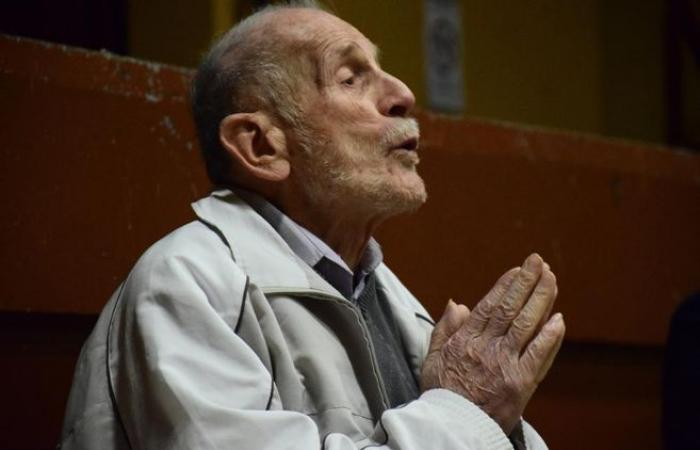
From his 9-year-old eyes to those of the octogenarian, Paul Dautraix has forgotten nothing of July 2, 1944. A morning when, hidden behind the shutters of his room, he witnessed the killing by the Germans of the resistance fighter Antoine Mosnier, in Villemorie.
Paul Dautraix takes a deep breath, his eyes almost closed. The moment counts for him, in front of the 29 delegates of the college of Saint-Georges-de-Mons (Puy-de-Dôme) who have come to listen to his story in the town hall, which has suddenly become a confessional, 80 years after events that he describes with extreme precision. “What I saw, I hope you don’t see,” he warns, in a very emphatic voice, without a single tremor.
“We saw the bombs explode”: 80 years after the bombings of Saint-Floret, witnesses say
And eighty years later, his memory retraces the path to Villemorie, a commune of Saint-Angel where he was born on November 15, 1935.
A native hamlet and this house on the corner on the road to Charbonnières of which he has forgotten nothing. For better and above all, on this day, for worse.
“I’m going to tell you what I unfortunately saw and what I have never forgotten…,” he begins. “I am the last to have seen Antoine Mosnier alive and above all dying. Almost dead.”
“Beautiful as today”
On that day of July 2, 1944, the weather was fine, “like today” and 9 o’clock had just struck when German trucks, “maybe forty of them”, entered the peaceful village. Little Paul was in his bed when the Germans got out. “I got up and stayed behind the windows where I could see everything that was happening”, he recounts, describing the shutters that hid his view. Was he afraid? “I don’t think so”, smiles Paul Dautraix.
80 years ago, the Gerzat roundup in Puy-de-Dôme
The occupier then looked for several resistance fighters, among them Mr. Corner, “a child of the assistance”, Mr. Guignabodet, Mr. Taconnet “whose whereabouts were never known” and who managed to escape, despite the shots, into a wheat field when he saw the convoy arrive. And finally, Antoine Mosnier who lived there with his mother, Hortense, a war widow.
Refractory to STO
Betrayed by his closest neighbors, informants of the Militia, this STO draft dodger, who joined the Resistance within a group of sedentary members of the MUR (United Movements of the Resistance), a maquis in Saint-Gervais, responsible for the placement and accommodation of draft dodgers, tried to escape. Unfortunately, handicapped by a knee injury sustained a few days earlier while killing a calf, he was quickly recaptured.
Two Germans came and got him, took him by the arms and led him under my bedroom window.
” A horror “
Pinned against the wall, the torture of the resistance fighter begins in order to obtain information on the Youx maquis. “I saw everything that was happening… A horror”, Paul Dautraix says modestly. The blows of the rifle butt follow one another on the unfortunate man, constantly getting him back on his feet by his torturers.“It lasted… I can’t tell you, maybe 15 or 20 minutes but it was horrible,” admits Paul Dautraix. Almost dying, the resistance fighter was finally loaded into a truck and taken to the woods of Genestines where he was shot dead.
80 years after his assassination, a vibrant tribute was paid to Jean Zay in Cusset
The young Paul Dautraix saw it, heard it and took it in from his family members. The same day, around 1 p.m., resistance fighters arrived in the village to look for Mrs. S., her daughter Solange, and Mr. P., collaborators suspected of having sold Antoine Mosnier. “They took them and took them a kilometer from the house, to La Boucheratte, in a ravine,” relates Paul Dautraix. Mr. P. was shot while Mrs. S. was left for dead, wounded in the stomach.
An agony at the top of the village
“Solange was able to leave but we never found out what happened to her,” explains Paul Dautraix. Once the resistance fighters had left, Madame S. was able to get up and go to the Chabrats’ house next door to ask for a glass of water. Anna Chabrat reportedly told her “that you can’t refuse a glass of water.”Seriously injured, Mrs. S. then reached the top of the village, accompanied by her little dog, Kleber, where she was to die in a stack of straw. “Around 7 p.m., her dog was found by the resistance fighters who took them to his mistress,” adds Paul Dautraix. Her agony was shortened by the resistance fighters.
“It shouldn’t start again. That’s why the commemorations are necessary. I have a little regret that we don’t see more children at the war memorials. We have to tell them that if we are This is thanks to those who died for us. Antoine was 24 years old…”
Paul Dautraix (empty)
Three weeks later, militiamen invaded Villemorie and searched every house, including that of young Paul. “I had a plaster piggy bank representing a blacksmith. They broke it in the middle of the kitchen before moving the house from top to bottom.” They found nothing, especially not the resistance greatcoat hidden in a bed by Mr. Taconnet, who came to sleep at the house from time to time.
A youth in the shadow of the martyrs of June 9, 1944 in Tulle
At Riom prison
Two resistance fighters’ houses were set on fire while several villagers, including Paul’s father and grandfather, were gathered in a courtyard before a sorting process was carried out. Some were released, others were taken to Saint-Angel and then to Riom prison to be interrogated and released or sent to Clermont. “My father remained in the prison where he was freed by the Americans,” concludes Paul Dautraix.
Antoine Mosnier, dead at 24
Born on September 6, 1920 in Saint-Angel, Antoine Mosnier was 24 years old when he was tortured and then executed by the Germans on July 2, 1944, in Saint-Angel. A navvy at Ponts-et-Chaussées, he lived on the road to Châtel-Guyon in Riom before moving to Villemorie in Saint-Angel with his mother, a war widow, his father having been killed during the fighting in the First World War. Refractory to the STO, he joined the resistance within a group of sedentary members of the United Resistance Movements, maquis of Saint-Gervais. He was in charge of the placement and accommodation of the refractory. Antoine Mosnier was recognized as “Mort pour la France”, approved by the FFI for the period from November 10, 1943 to July 2, 1944. On May 6, 1955, he was posthumously awarded the Volunteer Resistance Fighter card. His name was inscribed on a commemorative stele in Châteauneuf-les-Bains as well as on the Saint-Angel war memorial.
Sources: https://maitron.fr/spip.php?article199335, notice Mosnier François, Antoine by Eric Panthou.
His eyes close again. As if collected and soothed by having given his testimony, which he had never had the opportunity to do publicly, before the invitation of the mayor of Saint-Georges-de-Mons, Julien Perrin, present at his side. “It shouldn’t happen again,” he continues, more serious and in a voice with a singular energy. “That’s why commemorations are necessary. I’m a little sorry that we don’t see more children at the war memorials. We have to tell them that if we’re here, it’s thanks to those who died for us. Antoine was 24 years old…”
A stele dedicated to Antoine Mosnier
A life frozen in the eternity of sacrifice, by the torture that Paul has never forgotten in 80 years, proposing the installation of a stele dedicated to the memory of Antoine Mosnier, in 1989. And if he no longer lives in the house with the shutters, the octogenarian sees it exactly, down to those drops of blood that had marked the old plaster. “It shouldn’t start again…”, he reiterates. No 9-year-old child should have to live it again.
Germans. The German column was a reinforced section of the 7th Company of the SR 192, commanded by Lieutenant Viebahn, a group of heavy machine guns (13th 192) as well as 15 men from the Saint-Amand militia.
François Jaulhac





